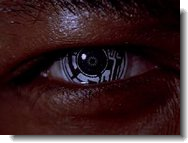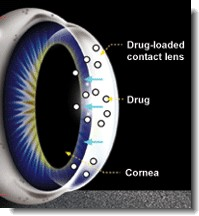
Thanks To:
http://www.wired.com/wired/archive/14.07/images/found.jpg
http://www.wired.com/wired/archive/14.07/images/found.jpg
Photo: Peter Samuels
Illustration: Jason Lee
Illustration: Jason Lee
"You already know about contacts, right? Wanna see one?" Her hand came away from her eye. A tiny disk sat on the tip of her middle finger. It was the size and shape of the contact lenses he had known. He hadn't expected more, but... he bent closed and looked. After a moment, he realized that it was not quite a clear lens. Speckles of colored brightness swirled and gathered in it. "I'm driving it at safety max, or you wouldn't see the lights." The tiny lens became hazy, then frosty white. "Ok. It powered down. But you get the idea.."

The Future Of Contact Lenses: Fact And Fiction
What can we expect in the way of improvements to contact lenses in the future? There are many fictional accounts that are quite exciting and revolutionary, unfortunately they're a bit advanced for our technology at the moment, and will probably remain fictional (for now, at least). There are, however, some amazing advances in contact lens technology that are being developed that may soon be available to all of us. Let's take a look at a few of the fictional accounts first:
Future Contact Lenses: Fiction
In the science fiction novel "Rainbows End" by Vernor Vinge, set in the year 2025, a recovering Alzheimer's patient learns to adapt to a world in which the real and the virtual blend perfectly. In one chapter, the author describes a future version of the contact lens:
The novel inspired the creative types over at Wired magazine to depict a near-future "Wi Fi" enabled contact lens (right), that displays everything from your location (using GPS) to the time and weather!
Star Trek has been inspiring inventors for years, in fact the modern cell phone was actually inspired by the "communicators" from the original series. This "ocular implant" used by the Geordi Laforge character from the Next Generation (right) was distinguished by a vibrant blue color with mechanized details on the pupil and iris. The implant gave Laforge telescopic vision that included heat detecting infrared. This technically wasn't a contact lens, but we think it may have inspired the following registered patent, which we will file under "fact":
Future Contact Lenses: Fact:
Above:
The future of contact lenses, powered by Google!
The future of contact lenses, powered by Google!
Above:
Geordi's "bionic" contact lens!
Geordi's "bionic" contact lens!
Recently, E-Vision of Roanoke, Virginia filed a patent for a revolutionary contact lens that will automatically adjust focal length (focus) using liquid crystals and built-in range finder. The system consists of a contact lens, an “electro-active” element layer (the liquid crystals) attached to the lens, a view detector in electronic communication with the electro-active element, and an external power source.
Essentially, the view detector will use sources such as lasers, radio waves, microwaves or ultrasonic impulses to judge the distance from the object being viewed by the user. This information is communicated via a controller, which adjusts the amount of voltage applied to the layer of liquid crystals, which adjusts the index of refraction.
Essentially, the view detector will use sources such as lasers, radio waves, microwaves or ultrasonic impulses to judge the distance from the object being viewed by the user. This information is communicated via a controller, which adjusts the amount of voltage applied to the layer of liquid crystals, which adjusts the index of refraction.
Another future contact lens idea that seems more promising originated at the University of Florida, where researchers have developed “drug-laden” lenses to deliver medication at precise intervals.
The soft contact lenses were developed for people suffering from glaucoma or other eye disorders, and use tiny drug-filled “nanoparticles” capable of releasing medication slowly and steadily into the eye. The particles are actually mixed with the material used to make contact lenses before they are manufactured, and do not interfere with normal vision. These lenses would be a lot more efficient than regular eye drops, which tend to release most of their medication into the bloodstream and not the actual eye where it is most needed.
Keep watching these pages, as we will always be posting new developments in contact lens technology.
The soft contact lenses were developed for people suffering from glaucoma or other eye disorders, and use tiny drug-filled “nanoparticles” capable of releasing medication slowly and steadily into the eye. The particles are actually mixed with the material used to make contact lenses before they are manufactured, and do not interfere with normal vision. These lenses would be a lot more efficient than regular eye drops, which tend to release most of their medication into the bloodstream and not the actual eye where it is most needed.
Keep watching these pages, as we will always be posting new developments in contact lens technology.


Above:
Will we ever have bionic eyes?
Will we ever have bionic eyes?
Above:
These contact lenses may replace eyedrops forever.
These contact lenses may replace eyedrops forever.
The patent doesn’t really explain where this power is coming from, and the inventors don’t seem to know exactly which way the viewfinder will judge distances. So technically, this should be filed under “semi-fact”. We look forward to the day this becomes a reality, though.
Contact Lenses | Glaucoma | Just For Fun | Eyeglasses | Eye Doctor | Eye Care And Symptoms | Eye Anatomy | Online Eye Tests | Laser Eye Surgery | Laser Eye Surgery Directory: Canada | Laser Eye Surgery Directory: USA | Laser Eye Surgery Reviews | Submit A Review | Contact Us | Privacy Policy | Sitemap
Copyright 2006-2009 Vision Health


